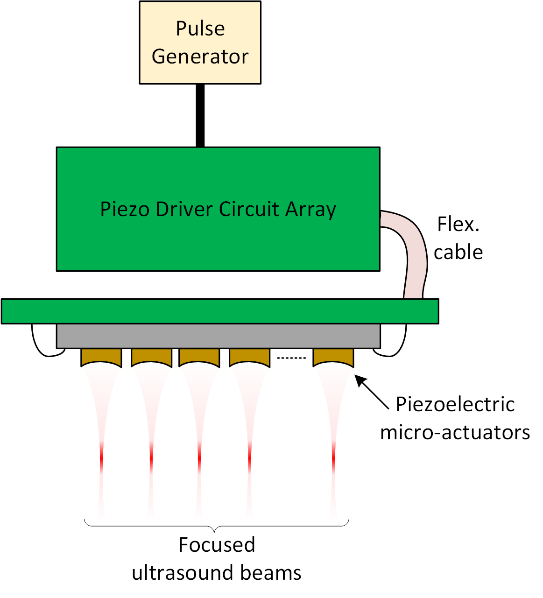MSc thesis project proposal
[2021] Piezoelectric micro-actuators for high resolution ultrasound brain stimulation
Currently emerging as new modality for interfacing with neuronal circuits in the brain is the field of focused ultrasound stimulation [1]. Traditionally used in diagnostic medical imaging, the propagation of ultrasound energy in soft tissue provides very different and attractive properties for usage as a neurotechnology modality when compared with traditional electrophysiology or optogenetics methods: it can be applied non-invasively at the surface of the skull or minimally invasive at the surface of the dura mater, can penetrate several centimeters in the brain due to very low scattering, and can be focused in specific locations with high precision and millimeter and sub-millimeter spatial resolution. This field of research has been moving forward based on evidence obtained from experiments, from stimulation of the hippocampus in mice, to somatosensory and visual cortex in humans. However, the current major drawback of this stimulation modality is the big form factor of the ultrasound transducers used in the abovementioned experiments, normally limited to one transducer, and hence, one stimulation site, and requiring rack-mounted bulky electronics for signal generation. Another possible obstacle of this method is the fact that the mechanism by which ultrasound activates or inhibits neuronal activity is still largely unknown. Even though some hypothesis have been tested [2], these experiments are still indirect and do not provide conclusive answers, mostly due to the complexity of the experiments and due to the difference in spatial scales from neurons to the used ultrasound wavelengths.
The goal of this project is to model, design, fabricate and test piezoelectric micro-actuators for high resolution brain stimulation. By combining the micro-actuators with an electrical interface in a PCB, the form factors of the system became much smaller, which decreases the complexity of experiments and allow for stimulation of multiple locations in the brain. Furthermore, by carefully setting the ultrasound frequency, the wavelength of transmitted acoustic waves can be in the same order of magnitude of small groups of neurons, which can lead to a better understanding of the ultrasound brain stimulation mechanisms.
References:
1. Tufail, Y. et al. Transcranial pulsed ultrasound stimulates intact brain circuits. Neuron 66, 681–94 (2010).
2. Fomenko, A., et al. (2018). "Low-intensity ultrasound neuromodulation: An overview of mechanisms and emerging human applications." Brain Stimulation 11(6): 1209-1217.
Assignment
1. Literature review on miniaturized ultrasound transducers for actuation.
2. Finite element modelling of different ultrasound micro-actuator designs.
3. Design and microfabrication of the selected micro-actuator types.
4. Ultrasound characterization of the micro-actuators
Requirements
MSc students from Microelectronics, Biomedical Engineering or Mechanical Engineering. Interested students should include their CV, list of courses attended and grades obtained.
Contact
dr. Tiago Costa
Bioelectronics Group
Department of Microelectronics
Last modified: 2022-01-27
